#age related infertility
Explore tagged Tumblr posts
Text
I have a weird relationship with the age-related infertility discussions. Does aging affect fertility? Absolutely. But are you doomed to never or not likely get pregnant if you "wait too long"...? That's where the conversation gets complicated, but no one seems to understand why it's complicated, let alone admit that it's not ever simple.
You see, it can take 7 or more years for a woman with endo, PCOS, etc to get diagnosed and properly treated for it. This means that her teen and young adult years are spent festering her undiagnosed complications until she reaches her 30s or so, and not only has perimenopuase to worry about, but her untreated disease(s) also. These compounding factors, obviously, makes it hard to get and stay pregnant.
And that doesn't even get into how terrible treatment is! Even when endo/PCOS/etc ARE diagnosed early on, they are --- surprise! --- given HORMONAL BIRTH CONTROL to "treat" it. At best, you get mild BC side effects while the condition never gets better, and you still struggle later on. At worst, you have someone with: severe nutritional deficiencies, wrecked gut and mental health, and other health risks that make pregnancy difficult to achieve down the road (or increase maternal health risks even if she does get pregnant).
Is age a factor? Yes. But assuming the woman is healthy and properly taken care of, it's a factor that shouldn't raise alarms. It may take longer for her to get pregnant, but a woman in her 30s and even 40s can achieve a full term pregnancy with the right support and knowledge. After all, women in the past traditionally had their last child in their EARLY FORTIES.
The issue is that everyone looks at age and nothing else. They don't question why it takes so long for female reproductive diseases to get treated and addressed. They don't question why fertility awareness is continually suppressed by the medical establishment. They don't question why women struggle to be taken seriously by their care provider.
I guess for them, it's easier to gaslight and shame women than to address the system that allows infertility to fester to begin with.
93 notes
·
View notes
Text
when I was like 15, a drunk woman I didn’t know at a party who was smoking a cigarette on the porch started randomly opening up to me about her infertility journey and I told her how I was my parents rainbow baby after multiple miscarriages and fertility treatments said not to lose hope. she comforted me about being a strange kid without many friends my age (hence why I was at a party full of adults thrown by my uncle) and told me everything would work out eventually. the next time I saw her like 2 years later (small town, mutual friends) she was carrying her newborn. I think about that a lot. it’s easy to feel disconnected from people and but sometimes just talking to them and hearing their point of view and relating makes you feel less alone. even if you’re only each other’s company for a few moments.
38K notes
·
View notes
Text
It’s kind of funny to me that the Djesh started as an afterthought/side joke that didn’t feature largely in the plot but have absolutely become the most interesting part of the story to me.
They’re big old parasitic xenomorph-lookin space bug women, right? They do not have a binary sex—only a select few choose to metamorpihize into a reproductively mature imago, while the others remain infertile neonates for their entire lives. Functionally they are all hermaphroditic and can reproduce sexually or asexually depending on environmental pressures. But also: they’re all women. As far as they’re concerned, so is everyone else.
Their closest concept to gender is relational:
A mother is anyone who creates with her body. This could be a literal gestational mother who lays eggs, fertilizes, or gives birth, but it can also mean a creature or person serving as host to the parasitic larvae. A mother in this sense is typically a final, fatal role immediately preceding death.
The Djesh do not distinguish between “mother” and “aunt” but for translation purposes it’s easier to explain with different terms. An aunt is a type of parent who participates in the rearing of young. If a mother or host survives and helps to raise a child, it counts as an aunt-parent. An aunt’s role is to teach and protect and to transmit stories from one generation to the next. An ideal Djesh family consists of many aunts raising young communally—possibly dozens. A family with too few aunts is considered deeply taboo in a way that’s comparable to incest. A Djesh encountering a two-parent nuclear human family for the first time would be horrified and disturbed and have trouble accepting that an intelligent species would reproduce like animals.
A sister is any independent adult who is not actively occupying a parental role. An aunt will revert to sister when her young reach adulthood. An aunt who abandons her role before then is committing a grave taboo—if a Djesh encounters a human who has been deployed on a military or scientific endeavor and left children at home, she will be repulsed and disturbed and potentially hostile.
A daughter is anyone, specifically a child, dependent upon a caregiver. I haven’t made up my mind yet on how this intersects with Djesh conceptions of disability but it’s something I may want to explore.
A Djesh will continue to molt and grow indefinitely. It’s possible that they have the technical capacity for immortality, with no set upper limit. They can regenerate limbs with each molt of their skeletons. As they age, however, the time between each molt grows longer, and the process becomes more difficult and perilous. Because this molting process functions as the only natural limitation on lifespan, there is a taboo against interfering. To succumb to the temptation to help a loved one with a bad molt that would otherwise kill them is to curse them and is a kind of spiritual betrayal… it’s very evil and very, very romantic. The idea of it is horrifying and tragic but they also eat that shit up like it’s Shakespeare.
Most importantly, of course, the Djesh are biologically dependent upon stories. They cannot be Djesh without them. You could incubate and hatch a Djesh egg in a laboratory and provide the larva with all the nutrients it required, but unless you (and, ideally, your entire team) spent time constantly telling it stories, it would never grow into a Djesh. It would survive, sure, but it would take the form of a weird gelatinous animal. This is why Djesh familial units consist of many aunts: the stories and narratives they pass on give Djesh children physical form and act as genetic information more substantially than whatever they inherit biologically. The more stories, the more diverse and robust their DNA-analogue. This is why most Djesh remain neonates and die infertile—they are able to reproduce more effectively by passing down stories than by producing/fertilizing eggs.
Turantirok is sometimes described as the Djesh “religion”. And it is, but only sort of—different populations may have different mythologies and beliefs, but turantirok is better defined as the cosmic force that drives narrative. To other species, Djesh may seem to behave erratically and seemingly act against their own interests. Even those few who manage to get around the language barrier struggle to understand the Djesh, and they are broadly regarded by other species as dangerously insane. In reality, Djesh have an innate instinct for turantirok—they will act according to whatever they believe best furthers a cosmic narrative, up to and including self-destruction. This was an evolutionary adaptation to pass on better stories to their descendants, but now that their planet is incorporated into a galactic civilization, turantirok may be an existential threat.
330 notes
·
View notes
Text
It’s a shame that the core four’s ages are never confirmed in canon. Arthur’s age is the best we get, and even then, it’s not that simple.
The dragon was captured exactly 20 years before Merlin came to Camelot. This means that Arthur is certainly over the age of 20 in 1x01. I’d argue that he should be over the age of 21 if the Purge had not only been going on for some time, but had already progressed into Kilgharrah’s capture by that point 20yrs prior.
If we take each episode as ~1 month (making each season ~1 year long), then Arthur’s birthday being in 1x09 would indicate about 9 months’ difference from 1x01, meaning that — if Arthur is 20 here — he was born only 3 months prior to the dragon’s capture.
This would mean that it only took 3 months for Uther to 1) wage his war, 2) escalate it so severely that Balinor summoned Kilgharrah to make peace with Uther, and 3) manage to capture Kilgharrah in chains specially designed to keep a dragon. This is incredibly unlikely.
I propose that Arthur is actually 21 in 1x01, giving Uther ~1 year and 3 months to wage war and orchestrate Kilgharrah’s capture.
From there, we can guesstimate Merlin’s age, since his birth is a direct result of this event. 20 years prior to 1x01 is when the dragon was captured, and so too was Merlin’s father. Then, he would have spent a period of at least a few months or 1+ years in Ealdor (long enough for him to fall in love with Hunith, and enough to never love another woman like that ever again). Then, he left Ealdor before he could discover Hunith’s pregnancy (i.e. she was not showing).
Accounting for the time Balinor spent in captivity, then the time spent in Ealdor, and of course the 9 months of pregnancy (which would have had some overlap, but small enough that Hunith was not showing), we get a period of at least one year, possibly even 2 years, after the dragon’s capture (again, exactly 20 years before the events of 1x01).
Subtracting 1 year, or 2, or whichever number we decide is most realistic from that 20 year figure, Merlin could be any of a wide range of ages in 1x01. At the oldest, he is a little over 1 year younger than Arthur (21 - 1.5 = 19.5). The youngest he could be is ~16 (based on appearances and relative age, since the numbers alone don’t place a limit on his minimum age) but it’s safe to say he’s at least 17 when he leaves Ealdor. So, 18 or 18 and a half would make for a functional average.
There is little to go off of for the Smiths, but Gwen is likely to be somewhere right between Merlin and Arthur’s ages since she has romantic plot-lines with both. She is likely ~19 in 1x01, older or younger depending on which figures we’re using. Elyan is implied to be younger than Gwen in 5x06 (when he says that Gwen “practically raised [him]”), so he may be Merlin’s age or younger. Only tangentially related, but Gwen says in 3x07 that it’s been 4 years since Elyan left. This places his departure ~6 months prior to 1x01.
As for Morgana, her age is dependent on when Uther slept with Morgana’s mother. Gorlois was off in battle when this happened, so it may have been post-Purge. However, because Morgana’s magic is an inherited trait (as it is with her sister, Morgause) and she and Morgause have the same mother but not the same father, this makes the magic a matrilineal trait in their family. It is highly unlikely that Morgana’s mother — a woman with innate magic — would have slept with Uther during the Purge. It was likely pre-Purge, and at least a year before Arthur’s birth.
Furthering the latter possibility, Uther having a child out of wedlock would be the evidence he needs to confirm the reason he has no child with his own wife (only his best friend’s wife): Ygraine is the infertile one. (Uther, on the other hand, is a little too fertile for his own good).
Compiling the timelines of these events, with enough time passing for the conception of Morgana to be realized, enough time for Gaius to persuade Nimueh to help Uther and Ygraine conceive, and enough time for Ygraine to complete a full 9 month pregnancy, we’re looking at a minimum of ~1 year and a half, but probably 2+ years if Uther and Ygraine looked into other (ineffective but time-consuming) fertility options first (via Gaius?).
Therefore, Arthur and Morgana might have a good 2 years between them. If Arthur is 21 in 1x01, then Morgana is probably ~23.
So my best guesses for 1x01 ages are:
Morgana: 22-23
Arthur: 21
Gwen: 19-20
Merlin: 18-19
Elyan: 16-18
163 notes
·
View notes
Text
Astro obs part 10 (mostly Saturn related lol)
🧸 Individuals with Sun trine/sextile Saturn tend to have a great relationship with their grandparents (if they were a part of their life, ofcours). They usually inherit lots of traits from their grandparents
🧸 Sun trine/sextile Saturn people also have a great moral compass and sense of justice. They follow rules and regulations and are well seen in society (unless Saturn is retrograde, then they still try their best to be exemplary, but they might fail from time to time)
🧸 Most Libra Moons i've met went to law school for their university degree
🧸 Saturn in 1st house people tend to look really good when they get older. When they are young, they might often look older than their age, but once their Saturn Return hits them, they age up like "fine wine" from that moment on
🧸 Saturn in 2nd house individuals literally fit the "old money" aesthetic. Often times they come from a wealthy family. If they don't, then they are very motivated to work hard and become millionares. Bonus points if their Saturn is at 28°/29°, as 28° signifies the household degree (being famously known for your family OR in your family) and 29° signifies long-term fame for completing a (often times) karmic cycle and reaping its rewards
🧸 Saturn in 4th house peeps have always felt like the black sheep of the family. Often times they end up abandoning family traditions in the pursuit of following their own individual path. Growing up, they have often felt lonely in their family and shy around people they weren't familiar with
🧸 Saturn in 5th house individuals take their hobbies and passions seriously. They could pursue one of their hobbies/passions as a career later on. Child prodigies tend to have this placement. If there are other planets in the 5th house, those can give hints on the "talent" (but in the case of Saturn here, it's not talent, just hard work)
For ex. Saturn and Venus in 5th house - pursuing art/fashion/make-up/singing/baking sweets as a career
Saturn and Mars in 5th house - pursuing martial arts/race car driving/working out as a career
Saturn, Mercury and Pluto in 5th house - pursuing drama writing as a career
The exception would be for Saturn and Jupiter in 5th house - these people tend to have multiple talents that they could turn into careers
🧸 Saturn in 5th house is also often an indicator of an unhappy childhood. This child felt like a lot of expectations and responsabilites were placed on him by his parents from an early age. Another meaning of this placements would be that Saturn in 5th house children were brought up by their grandparents
🧸 Those with Saturn in 11th house feel more comfortable befriending people who are older than them. They're also not very keen on the latest technologies and prefer sticking to the ideals of the past long gone (aka they love victorian era and prefer to live like they're a gal/man from the 19th century). They also tend to be interested in politics
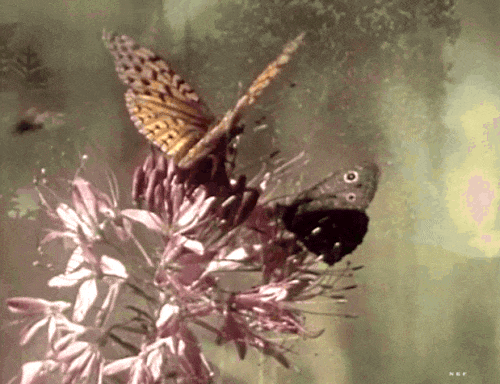
🧸 Earth Venuses and the type of chocolate they love:
Taurus Venus - milk chocolate
Virgo Venus - white chocolate
Capricorn Venus - dark chocolate
🧸 Individuals with Chiron in 5th house tend to struggle with infertility issues from a young age
🧸 Uranus in 3rd house individuals prefer taking short-haul flights when travelling short distances, while Uranus in 9th house individuals prefer taking long-haul flights when travelling long distances
🧸 Neptune in 6th house people make great psychologists and psychiatrists!! Often times these people have had a long history of dealing with certain mental illnesses, but instead of wallowing in their pain, they are inspired to help others overcome their own issues. Their capacity to emphasize with people's emotions is heightened, as they tend to relate to many of their client's symptoms. These people are also fit as somnologists (sleep doctors)
🧸 The sad part of Neptune in 6th house is that they often have to deal with stomach issues :( Their digestive system is extra sensitive, so they need to be careful with what they eat
🧸 Wanna know if you're secretly Jewish? Check out asteroids Hebrewu (271763) and Israel (7507) in your natal chart and your family's natal charts. If you find atleast one of these asteroids aspecting the angles (ASC, DSC, IC, MC), Sun or Moon in your chart and your family's charts, then there's a high chance you've got Jewish ancestry
🧸 In synastry, if your Ascendant conjuncts another person's Ascendant (so your house cusps become overlays), it's very likely that you've experienced the same events during your lives. This person would be your mirrored soul, which can prove to bring a great understanding over oneself
🧸 While we're still talking about aspects in synastry, Moon conjunct Chiron is not for the weak ones!! The Chiron person must display a sense of maturity or atleast be emotionally evolved enough to be able to deal with the Moon person. Chiron can trigger Moon's childhood trauma on a subconscious level, while Moon can trigger Chiron's deepest wounds regarding their house's themes. They can either heal each other or wound each other even more. This conjunction requires a great deal of patience and understanding between Moon person and Chiron person
#astro#astro community#astrology#astro placements#astro observations#astro posts#astro notes#astroblr#astro blog#sun trine saturn#libra moon#saturn#saturn in 5th house#venus#taurus venus#virgo venus#capricorn venus#chiron#chiron in the 5th house#neptune#neptune in 6th house#asteroids#synastry
1K notes
·
View notes
Text

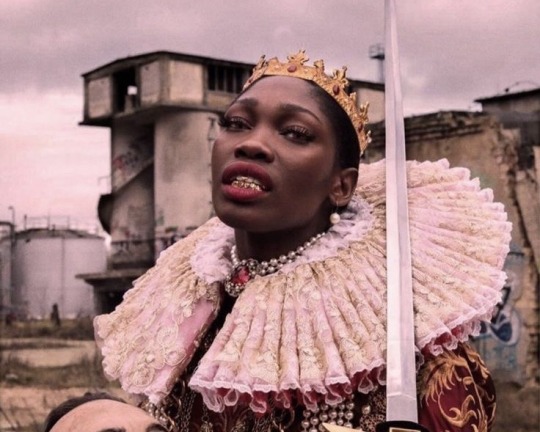
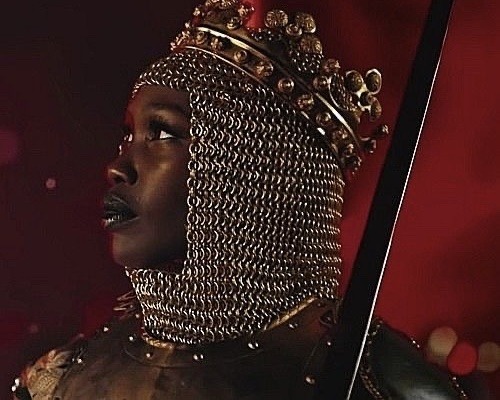

Mars asks:
“Why do you struggle?”
read for mars within a persona chart to learn how u may be challenged in that persona chart. mars is the planet representative of struggles and hardship, things not being achieved without a little strife or resistance. within persona charts, mars thus can represent how we may struggle to the core of the planet. remedy the planet to offset the malefic influences of mars. enjoy.

✶ ASC PERSONA CHART ✶
this shows challenges with the native's health, sense of direction, self embodiment/sense of self, spirit, and overall life, as the ascendant represents the moment the native came into existence. as the ascendant also tells us how we enter new environments; how we are "born," it can show those metaphorical ‘labor pains’ associated with that.
✶ MOON PERSONA CHART ✶
how u struggle to find security. it also tells u of what things may cause u to revert back to survival mode: like u have to protect or guard urself. things that challenge ur sense of comfort. it can cause a struggle in emotional relation, regulation, and belonging in community. it can show u ways u may struggle with ur mother, women around u, older sibling(s) if the native has one, or family/home environments as well. things that challenge ur ability to emotionally regulate. with fertility or hormonal balances.
✶ ☿ MERCURY PERSONA CHART ✶
how u struggle to communicate, think, write, process information, or relate to community as well. it can also show struggles with ur siblings. challenges ur ability to adapt to environment. and it causes struggle within the mind. struggles relating to focus, can show distractions.
✶ ♀ VENUS PERSONA CHART ✶
mars and venus are each others' detriment. in the venus PC, mars shows what challenges ur sense of peace. it also represents challenges/tension in romantic/sexual relationships (this could range anywhere from lowered libido to hypersexuality to abuse, sadly) venus is also the planet of our aesthetic and artistic expression, so mars in the venus PC can show how our creativity is challenged or how we struggle with it. how our pleasure, companionship, is challenged. it also tells us our struggles with femininity and/or women around u. challenges relating to forgiveness or reconciliation.
✶ ♂ MARS PERSONA CHART ✶
mars within the mars PC is the deeper expression of the natal mars. but since mars is a malefic, my theory is that this doesn't necessarily cancel out the malefic influence as much as it exposes the weakness of it. this can show a challenge with how u advocate (for urself & others), ur drive, ur libido. as mars is the warrior, it can also show generally how u struggle to triumph. struggles relating to health issues, with being subdued or authority figures; what "tortues" u. struggles to masculinity and/or men.
✶ ♃ JUPITER PERSONA CHART ✶
struggles of fertility/the womb/the semen/the liver, marriage (chiefly, fidelity), of attaining freedom and liberation. struggles with accepting blessings, gifts, fortune. hardships and challenges relating to trusting. to generosity. to alliances.
✶ ♄ SATURN PERSONA CHART ✶
the development of ur struggles and challenges as u age, karmic struggles, struggles with authoritative figures. challenges with shame and humility. how u are challenged by authority. ways u are troubled by reputation. challenges of the spiritual entities u possess. infertility. discipline.

#astrology#astro community#astro notes#astro observations#hoodreader#thoughts#theories#persona chart
97 notes
·
View notes
Note
I’m really tired of seeing all the ‘PCOS is an intersex disorder’ posts and think they’re extremely offensive to women with PCOS.
Please can you clarify that it is not (or if it miraculously is, I guess.)
Hello! You're correct PCOS is not an "intersex disorder".
First, what is an "intersex disorder"?
Currently, to my knowledge, there's a shift towards using disorders/differences of sex development (DSDs) rather than "intersex".
A DSD is a very specific group of medical conditions which is "restricted to those conditions in which chromosomal sex is inconsistent with phenotypic sex, or in which the phenotype is not classifiable as either male or female" [1].
The possible point of confusion is "phenotypic sex", in this context, this refers to primary sex characteristics (internal and external genitalia) not secondary sex characteristics (breast growth, hair growth, etc.). This is important because both primary sex characteristics and DSDs are present from birth. Although, in some cases, they may not be identified until later in life, they are still present at birth.
How does this relate to PCOS?
Polycystic ovary syndrome (PCOS) is a condition that only affects female people that affects secondary sex characteristics (e.g., cause male-pattern hair growth/loss). It can also affect the function of primary sex characteristics (e.g., cause infertility), but it does not affect the development or appearance of primary sex characteristics. [2]
Therefore,
Women with PCOS do not have a mismatch in genotypic (chromosomal) sex and phenotypic sex (primary sex organs). That is, they have XX chromosomes without any Y-chromosome translocations and a female-typical vulva/ovaries/uterus/etc. The fact that women with PCOS have irregular periods does not negate the fact that their uterus developed normally. In other words, problems with organ function are not equivalent to problems with organ structure/development.
They also do not have ambiguous genitalia; they have female-typical sex organs at birth. Notably, female-typical has a wider range than the commonly held (and misogynistic) “ideal”, but in all cases they are clearly identifiable as a vulva rather than a penis/scrotum.
The age of onset of PCOS is anytime after puberty, and therefore, not at birth. It is an endocrine (hormonal) condition, and no more a DSD than ovarian hyperthecosis, hypothyroidism, or hyperprolactinemia which all produce similar symptoms to PCOS (among many other conditions). [3-5]
Despite claims to the contrary, women with PCOS do not have "male-typical" testosterone levels. The average testosterone level is actually well within the healthy female range and even the upper-end of the PCOS range is around half the lower-limit of the healthy male range. This makes the primary evidentiary claim for PCOS being a DSD (i.e., "testosterone levels between men and women!") invalid. (This claim is also based on the incorrect, and intersexist, belief that people with a DSD are "between" or "neither" male or female.) [6]
All other arguments I can find for PCOS being a DSD appear to be based on:
The belief that we must expand the definition of DSDs to prevent discrimination. This is both logically inconsistent (i.e., we have no evidence that increasing the size of a minority group would reduce discrimination) and philosophically concerning (i.e., this rests on the belief/assumption that we can/should do nothing to reduce discrimination of very rare minority groups).
People's feelings about having PCOS/beliefs about people's feelings about having PCOS. This is wrapped up in postmodernist worldviews, and essentially posits that if people feel they are "between" sexes they should be treated as if they are, despite no material evidence supporting this feeling. (And, again, this also rests on the incorrect and intersexist belief that people with a DSD are "between" sexes.)
A related belief that that if people identify as intersex, we must affirm this identity. Again, this is wrapped up in the same postmodernist worldview, and all the standard criticisms apply.
Conclusion
All in all, there is no medical or material evidence that PCOS is a DSD. The philosophical arguments to the contrary relies postmodernist logic that rejects reality in favor of identity and being in favor of feeling. These arguments also rely on offensive stereotypes and beliefs about people with DSDs/intersex people.
I hope this helps you, Anon!
References below the cut:
Sax, L. (2002). How common is lntersex? A response to Anne Fausto‐Sterling. Journal of sex research, 39(3), 174-178.
PCOS (Polycystic Ovary Syndrome): Symptoms & Treatment. Cleveland Clinic, https://my.clevelandclinic.org/health/diseases/8316-polycystic-ovary-syndrome-pcos.
Shah, Sanket, et al. “Diagnostic Challenges in Ovarian Hyperthecosis: Clinical Presentation with Subdiagnostic Testosterone Levels.” Case Reports in Endocrinology, vol. 2022, Jan. 2022, p. 9998807. pmc.ncbi.nlm.nih.gov, https://doi.org/10.1155/2022/9998807.
“Hypothyroidism (Underactive Thyroid).” Cleveland Clinic, https://my.clevelandclinic.org/health/diseases/12120-hypothyroidism.
“Hyperprolactinemia: What It Is, Causes, Symptoms & Treatment.” Cleveland Clinic, https://my.clevelandclinic.org/health/diseases/22284-hyperprolactinemia.
Clark, Richard V., et al. “Large Divergence in Testosterone Concentrations between Men and Women: Frame of Reference for Elite Athletes in Sex‐specific Competition in Sports, a Narrative Review.” Clinical Endocrinology, vol. 90, no. 1, Jan. 2019, pp. 15–22. DOI.org (Crossref), https://doi.org/10.1111/cen.13840.
42 notes
·
View notes
Note
Hey, I noticed that in one of your posts you showed an Iron Age Finnish woman's dress. Would you happen to have a good idea of what Finnish men were wearing in that era? The information on it seems sparse. I do have a relevant book that I'm about to look through, but I'd like to hear your insight too!
Hi! Thanks for the question (and sorry for the slow answer), I do love Finnish Iron Age clothing so it's always my pleasure to write about it. I've been wanting to do a deep dive into this for a long while, so maybe I'll do at some point a post about women's dress too.
Unfortunately no one has good idea of the Finnish Iron Age men's dress (and if you find any book or other source that claims otherwise, do not trust it), since there's much fewer archaeological finds of men's dress than women's dress. The most accepted theory on why the textiles of women's dress survived surprisingly well is because of the bronze ornamentation commonly sewn into especially the fine women's dresses of the era. The bronze protected them from decomposing fully. Presumably men's dresses were not decorated similarly then. There are some finds though and we can piece together at least some kind of vague picture.
I will be discussing the period from Viking Age to Crusade Age in Finland. Viking Age is often defined to cover 800s to mid-1000s and the Finnish Crusade Age started right after the Viking Age and ended in the end of 1200s, where the Finnish Medieval era begins. Crusade Age refers to the period where mostly Swedish (also German) crusaders in the span of couple of centuries conquered lands of the Baltic-Finnic pagans. The crusades of this period targeted pagans all over eastern Baltic Sea, including Baltic-Finnic Karelians, Livonians and Estonians, and Baltic peoples, and the Scandinavia too, where Sámi people were targeted. After that the Finland and Sápmi were colonized by Norse people and stayed that way untill Finland was transferred under Russian rule, but to this day Sápmi still stays under colonial rule, including Finnish colonial rule. The current Finland was very multicultural area, mostly populated by Finno-Ugric peoples, including Sámi people, Karelians and various Finnish peoples.
It's important to understand that even just Finnish peoples where not homogeneous, but had distinct, yet of course strongly related cultures. These were Finns (suomalaiset) (yes most people we now call Finns were not in fact called that) in the coast of southwestern and western Finland, Tavastians (hämäläiset) in central-western lake-Finland and Savonians (savolaiset) in central-eastern lake-Finland. This means we can't mix findings from all over Finland to reconstruct a dress without evidencing that all the elements were actually used in one place. These three tribes had broadly similar base for their clothes, but distinctive jewelry and detailing. The big divide was and has always been between eastern and western Finnish peoples. This is because western Finnish people were in close contact through the sea with Norse people and southern Baltic-Finnic peoples, while eastern Finnish people, Savonians mostly, were influenced a lot by their proximity with Karelians. Another dividing factor was the very different environmental conditions between western and eastern Finland. The Finnish coast especially in west is very flat and fertile land, while the lake area, especially in eastern Finland is very rocky, hilly and quite infertile. The main way it effected clothing differences was that western Finland being more wealthy had more elaborate clothing. Tavastians in both occasions fall quite in between, but they tended to be more in the western cultural camp.
My most important sources are a study by a doctor of cultural anthropology, Jenny Kangasvuo, Savon historia I (Savonian history) digitized and open sourced here and the digitized archeological collection of Finnish Heratage Agency. They are all in Finnish so not very useful for most people unfortunately.
Finnish Men's Dress in Viking and Crusader Ages
The basic garments men wore were broadly similar as women. They wore a shift/shirt, knee or above-knee length dress, cloak, belt, shoes and some kind of headwear. Wool was used most commonly, though the shirt would sometimes be linen too. Even evidence of silk has been found in some western Finland graves. I would assume that would be from a dress of some great man, who traveled to gain riches, possibly with vikings. Embroidery and decoration with metals was a typical feature of the whole Eastern Baltic Sea area. In Finland during this period bronze was the most common decorative metal, but silver was used too. Decorative elements were usually woven with small bronze spirals into all kinds of patterns. Here's examples from the reconstructed Ravattula's dress (Finns) used by women.
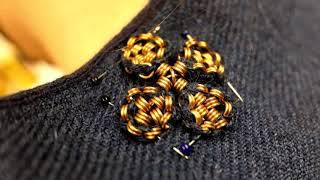
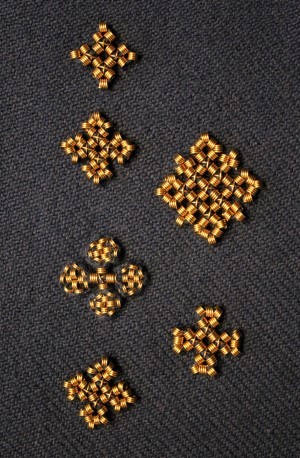
Shirt
The shirt (in Finnish shift of both women and men was called shirt) was basically a long shirt or under dress. We can assume it was similar to those of women's except shorter since the dress men wore was shorter too. They were made from wool or linen, I would assume wool was used in winter and linen in summer, when linen was even available. The neckline had a cut and closed with a bronze brooch. Horseshoe brooch was common. The first one is a quite typical bronze horseshoe brooch with a bit of ornamentation from Salo (Finns). The second one is from Tuukkala, (Savonians), it has exceptional ornate detailing and is uncommonly silver, not bronze. The third picture has two quite uniquely ornamented horseshoe brooches, first from Köyliö (Finns), second from Kurikka (Finns).
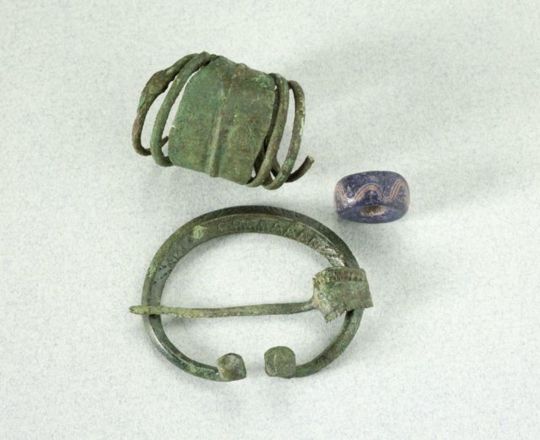


Legwear and footwear
Very little of men's legwear has survived and it's unclear weather men wore pants or separate pant legs, leg wraps or perhaps long socks. Evidence of strings decorated with bronze spirals and tablet woven band has been found in leg area of men's graves. This could mean that they wore either leg wraps, long sock or some sort of pant legs that needed to be secured with string or band under knee. Women used strings and tablet woven tape to secure leg wraps and socks, which I think supports that theory. Sometimes both bronze decorated string and tablet woven band was found in the leg area, which would still be explained by this theory, since it was common to decorate the ends of the bands with bronze decorated strings. Here's an example of sock bands just like that from the earlier mentioned reconstruction of the Ravattula's women's dress. Since men's dress was shorter, I think it would make sense if they still wore some kind of pants or separate pant legs with socks or leg wraps like that.

However, the strings and bands could have also been part of the shoes. Everyone probably wore similar shoes - laced leather shoes with a bit of pointed end. They might have been short or ankle length and the lacing was done with either leather cord or tablet woven band, which would also explain the findings. Socks or feet wraps would have been used in them, and straw or wool could be added as filling for warmth. Here's a pair of traditional Izhorian shoes from Estonia from early 1900s, and a pair of traditional Sámi shoes. The designs were likely roughly similar in Viking and Crusader Ages, though obviously more simple, and it's probable that Finnish shoes very something like that too. Here's a 1893 drawing of what findings of shoe material from Korpiselkä (Savonian or Karelian) might have looked like. Considering the quality of archaeology of that time, copious amounts of salt should be applied. And finally as a fourth picture there's reconstruction shoes from Ravattula's dress.
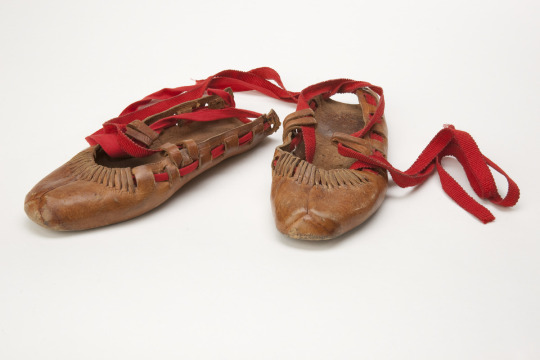
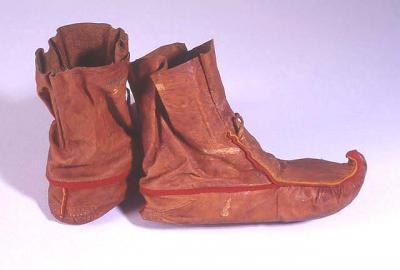
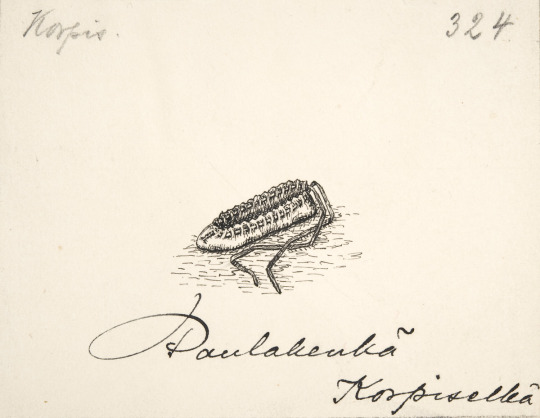
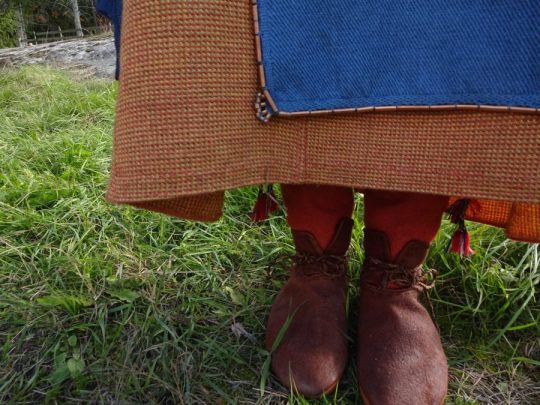
These are not necessarily mutually exclusive theories. The lacing of the shoe could have been laced up the leg and used also to secure either sock or leg wrapping, or they could have been separately secured in ankle and knee respectively.
In some graves twill fabric has been found in the leg area. It could be part of pants or for example leg wrapping, which was often made of twill. One theory about pants is that they were similar as some findings in Sweden, where fairly tight pants made of twill were secured at the hem with buttons similar to cuff studs. These kinds of cuff stud buttons are quite a common find in Finland and some have been found in men's graves close to legs.
Dress
Again there's not much findings of dresses, but a little more perhaps. It was usually from wool. The shape was either a tunic or an open coat. In Karelia there's findings of men's dress suggesting tunics thicker than women's dresses and made from sarka, a type of broadcloth. On the other hand, in Masku (Finns) they found buttons in a row on top of the torso, which suggest a coat closed with buttons. The first picture is a drawing of the grave find. Similary coak closing amounts of buttons have also been found in other places in western Finland. This suggests that Finns and probably Tavastians too wore long coats buttoned to the waist and Savonians wore tunic of Karelian influence. Below there's couple of version of what might this western Finnish men's coat dress could've looked like. The first is an imagined version of the coat based on the Masku grave finds, second is just as imagined version based on Eura (also Finns) grave finds.
Take these "reconstructions" with a strong dose of salt. These are more artistic reconstructions than scientific, since there's not enough material and too much guesswork needs to be done. And because we can see in the Masku grave drawing right here that the other deceased has a large buckle to (probably) close the shirt (to be fair, it could for a cloak too), like was typical, I find it implausible that the coat neckline would be small and round covering the buckle. If you make a decorated big buckle, I assume you want to show it. I would find a v-neckline more probable. It's also easier to make without wasting expensive fabric.


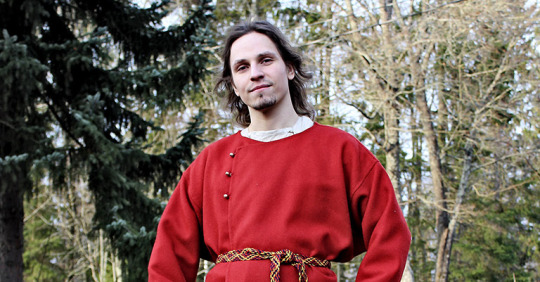
The buttons are interesting. There were what you would imagine - your typical buttons made of bronze like seen in the first artifact from Hattula (Tavastians). But then there was silver jingle bells used as buttons, found for example in both Masku and Eura graves, Eura findings pictured below.

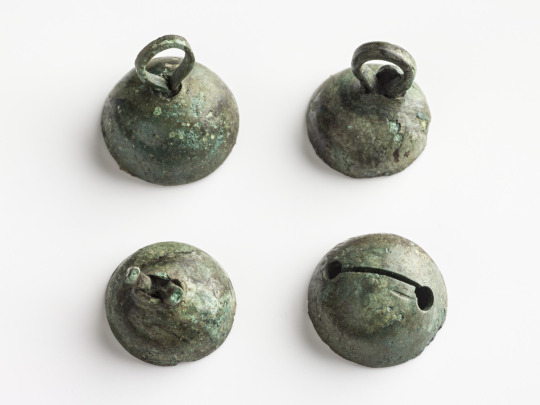
It's possible, even probable I'd say, that the hemlines of men's dresses were finished with tablet weaving patterns, like women's dresses. Also I would assume the pattern of the men's dress (and shirt) was mostly similar to the women's underdress/shirt patterns. So here's couple of different reconstruction patterns for women's dress. Different historians have made different interpretations of the patterns, so it's very much undecided what it really was like.


Belt
This is likely the most ornamental part of men's dress. They could be made out of leather or tablet woven band. And there's another east-west cultural divide here. Karelian belts were made out of leather, were usually 1,5-2,5 cm wide, decorated with iron or bronze studs and had a buckle made out of iron or bronze. These types of belts have been found in Savonia too, for example in Tuukkala grave find, which you can find very cool pictures of in this photo documentation of the dig in pages 173-175. In western Finland a "hela" belt was the common style. I don't think there's a world for hela in English. It's a sort of decorative lamella, small metallic plate (not necessarily square but often so) attached to fabric or leather with studs or sewing. Hela belt came from the Permians of Kama river, who were one of the many Finno-Ugric peoples who used to populate much of European side of Russia. Karelians lived closer to Permians, so you might think Permians would influence eastern Finland more, but my theory is that the costal Finns, who frequently joined viking crews and at least were in close contact with merchants including vikings, who would travel along the eastern route through the eastern European rivers, where they could go all the way to Kama river or at least meet traveling Permians. Here's yet another Finnish source more on the Finno-Ugric people around Kama river.
Anyway, hela belt was made of leather and filled with small decorated lamellas, often in square shape, but various other shapes too, like animal ornamentation. In this period hela belt helas were bronze. First image is a nice full set of hela belt metal pieces found in Pirkanmaa (Finns). Second is an older example, right before Viking Era, from Vaasa, costal settlement, (Finns), depicting a very Permian style. The third one is a lion hela found separately in Pälkäne (Tavastians). They are also found in Tuukkala, showing that both eastern and western cultural influences were present there at the same time.
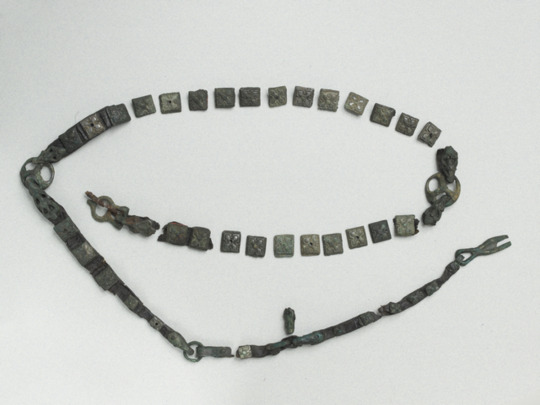
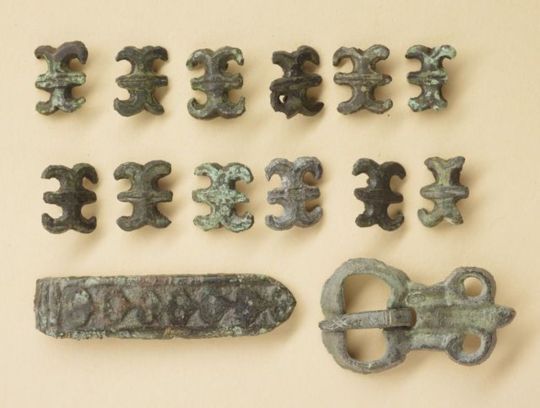

Another western Finnish belt type for men had intricate tassels decorated with bronze spirals hanging on the waist at the end of the belt. They could be made out of leather or tablet woven band. First image depicts a reconstruction of such tassel. Belts in east and west would have strap dividers to hang straps for things like purse, knife and sword. The first picture above has couple of those, but the second picture below has two more of them in more detail in the middle of the picture. These finds are from Lieto (Finns).
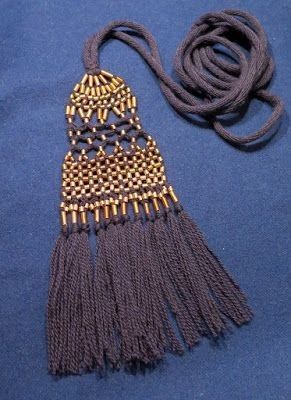
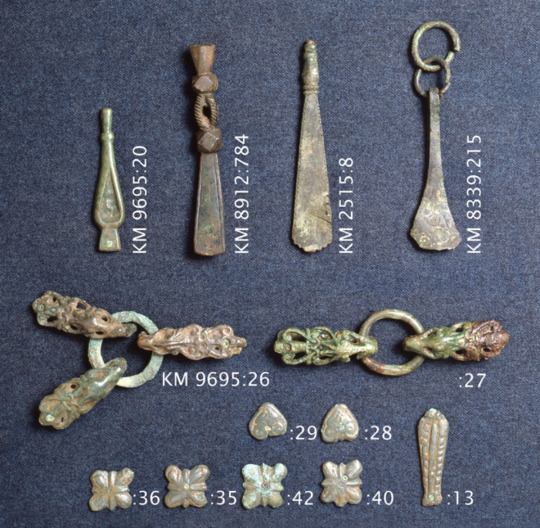
Cloak
Like women's cloak, men's cloak was woolen and either a square or trapezoid. Cloak is yet another east-west divide. In western Finland men's cloaks have embroidery with bronze spirals. They in fact appeared earlier in men's cloaks (in 900s) than in women's cloaks (1100s). They were also a little different in men's cloaks. The spirals and the patterns themselves were bigger and the fastening thread itself was also used for the pattern creation, unlike in women's dresses, where the thread was mostly covered. In eastern Finland there has been no finds of bronze decorations in men's cloaks, mostly only cloak brooches have been left of them. Unsurprisinly same applies to Karelia. This also means there's very little fabric left too. There's one exception. In Tuukkala (Savonians) they found a piece of fabric probably from men's cloak, though it could be from a men's dress too. It was striped, with possibly white or brown base and wide stripes of red, blue and yellow. So perhaps eastern Finnish cloak was not non-decorated, but the decoration was in the fabric pattern. Unfortunately it's hard to know how common fabric like that was, when so little of it is left.
Accessories
It's safe to assume men too wore some type of headwear, but none of those has survived. It probably means it was entirely made out of fabric whatever it was. Some type of hat or cap was certainly used in cold weather at the very least. Tablet woven headband was also possible option for not too cold weather.
In Tuukkala there was couple of interesting jewelry finds too. Two graves had a necklace type mostly found in Karelia. It was birchbark tape covered with nettle fabric and had square helas sewn into it. There were also more typical Finnish necklaces made of beads and bronze spirals.
Razors have also been found with men in their burials, so we can assume shaven faces or at least trimmed beards and moustaces were fashionable.
#dress history#historical fashion#historical clothing#fashion history#history#iron age dress#finnish iron age dress#finnish history#archaeology#answers#anon
227 notes
·
View notes
Text

My PMDD hell: why I went abroad to have my ovaries removed (Sarah Gillespie, The Times, Nov 27 2024)
"For six years, from my late twenties, I have lived with a condition called premenstrual dysphoric disorder, or PMDD.
Due to a genetic quirk, I have a brain sensitivity that makes my body intolerant to its own hormonal changes.
Instead of becoming moody and irritable, as with PMS, I become catatonic and racked with pain.
Dysphoria blooms in my brain, making me depressed and paranoid. I binge on carbohydrates, needing 3,000 calories a day just to function.
This happens for 7-14 days every month, during the latter half of my menstrual cycle, as hormone levels plummet.
On the third day of my period, the fog lifts and I feel normal again. But relief is soon replaced by dread as I survey the destruction.
There are relationships to repair, overdue bills to pay and excess pounds to lose.
It is the life of Sisyphus: every month, I roll the boulder up the mountain only for it to roll down again. (…)
PMDD is surprisingly common and, according to World Health Organisation data, affects 5.5 per cent of women of child-bearing age — about 824,000 women in the UK.
Of these, more than a third have attempted suicide. Yet hardly anyone’s heard of it.
No one knows the cause, either, though scientists generally agree that it’s genetic — hence why psychological therapies can’t fully fix it.
It was only in 2019 that the WHO added PMDD to its international classification of diseases and related health problems (ICD-11), legitimising it as a medical diagnosis (though there are still medical professionals who dispute its existence). (…)
After diagnosis, women with PMDD are put onto a ladder of treatments ranked from least to most invasive.
But as the body ages and hormones become more erratic, PMDD gets progressively worse.
So even when I found a rung on the ladder that worked, I never got to rest there for long.
First, there were lifestyle changes: diet, weight training, high-intensity interval training (HIIT).
Then supplements: chasteberry, evening primrose, magnesium, calcium, L-tryptophan, vitamin B6. Then antidepressants: fluoxetine, sertraline, citalopram.
Then contraceptives: Evra, Yasmin, Eloine. Finally, there was HRT: Utrogestan, Estradot, Estraderm.
I climbed that ladder for five years. Only HIIT and fluoxetine worked, for about nine months each; the rest worked for two months, if at all. (…)
After all this, only one rung was left on the ladder — one with a 96 per cent satisfaction rate, the closest thing to a cure.
This last-resort treatment is a bilateral salpingo oophorectomy: the surgical removal of both ovaries and fallopian tubes.
Upon their removal, all hormone fluctuations would stop, my hormone levels would drop to almost zero and I would enter menopause.
I would need to take hormone replacement therapy (HRT) until my fifties or risk the early onset of osteoporosis, heart disease and dementia. It would also make me infertile. (…)
Getting approved for surgery on the NHS requires a trial period in a reversible “chemical” menopause: monthly injections that would shut down my ovaries, end my suffering and “prove” that I had PMDD.
That was the idea, anyway. Instead, the injections threw my hormones into chaos, resulting in a PMDD episode that lasted for 11 months.
Deprived of even the monthly breaks in my symptoms, I languished in bed.
My attention shattered; I spent countless days scrolling my phone. I gulped down painkillers and sleeping pills like Skittles.
My finances were collapsing. I gained more than two stone in weight.
“It should be working by now,” the gynaecologist said after three months. “Have you tried eating more vegetables?”
The next gynaecologist was no better. “If it hasn’t worked, that suggests it’s not PMDD,” she said. “I should probably refer you to a psychiatrist.”
After months of my pleading, she agreed to write to the surgeon. But her letter was an act of sabotage.
“Sarah has diagnosed herself with PMDD,” she wrote, ignoring my GP’s diagnosis.
“She is on many help groups and accessing a lot of support from other PMDD sufferers online.” In other words: “This hypochondriac is spending too much time on the internet.”
Yes, I was on the internet, but I wasn’t talking to help groups any more.
Instead I’d been digging into scientific papers to find studies on chemical menopause.
Eventually, I found one — a meta-analysis of five clinical trials published in the Journal of Clinical Psychiatry.
It stated that chemical menopause treats PMDD in “upwards of 70 per cent” of cases — but not 100 per cent, as the NHS doctors had said.
The International Association for Premenstrual Disorders (IAPMD) backs this up.
On its page on chemical menopause it says, “In rare cases [chemical menopause] does not fully suppress the cycle and there are breakthrough symptoms… If this was the case, you may still respond well to surgical menopause.”
Two months later, I was in Lithuania. Feeling desperate and unable to afford the £10,000 it would cost for private surgery in the UK, I had googled “gynaecology surgery Europe”.
This led me to Nordclinic in Kaunas, which treats about 2,000 British patients annually.
I sent my medical records to the surgeon, who agreed to perform the surgery. (…)
Though it’s early days, I still can’t believe how well I feel. My future unfurls before me without interruption.
I have so much time: time to write, to see friends and family, to travel, go on dates, paint and sing and read and run.
Time to cook, as I can now handle knives without fear. Time to sit and do nothing and burst out laughing from sheer wonder — for life without PMDD is so, so wonderful and I will forever be grateful for it.
That said, I still need to reckon with all the time taken from me over the past six years.
My trust in our healthcare system is broken and will probably never be restored.
I need to kick away the crutches — food, phone, pills, alcohol — that have held me up and rediscover better ways to cope.
But this time, I don’t need to keep starting again and again and again every month.
Yes, the scars are still red and raw. But by next summer, they’ll be gone."
50 notes
·
View notes
Text
Just thinking about how easily Franchaela can work (for all the naysayers):
1. Francesca does love John. There's no debate (or, shouldn't be) about that. Just because her sparks with Michaela are altogether different doesn't negate her peaceful, quiet comfort with John.
2. Her infertility issues still very much have a place within her story—with John. They are married. They will have these issues come up. That part of her story has not been thrown out the window.
3. Michaela will still very much help—and join—Frannie as she grieves after John's death. John and Michaela are still cousins, close as siblings.
4. I know that many claimed they were disappointed in the change to Michaela since part of Francesca's fertility journey is that she does have a child with Michael pretty quickly. This could be easily included by Francesca having been pregnant again at the time of John's death, or by Francesca and Michaela adopting a child/children. Because of course Michaela would help raise John's child, her own relation as well. That could look a bit like Sir Phillip's situation.
5. There could be a number of ways the Bridgerton world approaches queer relationships. Either the influence of the Bridgerton's (and the Stirling's, another family of the ton) will lead the Queen to deem queer couples accepted by the ton, or Francesca and Michaela can be presented as companions, as many real life queer couples of the age would have done. If they go this route, it's unlikely that they would be questioned or face much scrutiny. They are relatives by marriage, Michaela should still inherit the title and Kilmartin, and Francesca would be afforded more freedoms in society as a widow: she has already experienced the marriage mart, would be the dowager Countess, and still comes from an influential family besides.
All in all, this scenario can work out really easily. If this post alone helps convince even one person of that, I'm happy. We all interpret characters in different ways, and for Brownell, that's envisioning Francesca as a bi, neurodivergent woman. Considering that Julia Quinn approved this change, and affirmed that it will be keeping to the heart of the story, I'm not too sure why there continues to be a debate about this (or a call for a re-do, which logically would never happen). If you have any other ideas of how the showrunners may depict Franchaela, please share! I'd love to discuss their coming story more ♡

#bridgerton#period drama#francesca bridgerton#michaela stirling#franchaela#francesca stirling#john stirling#francesca x john#francesca x michaela#netflix#julia quinn#shondaland#shonda rhimes#jess brownell
88 notes
·
View notes
Note
hiii! Since they're hellborns , and not sinners, there's some reason why Rosie and Zestial are born in the centuries you said? I'm curious!
hi! ofc I'll answer :D
• Zestiel has been around since time of King Arthur, — the world was undergoing severe territorial upheaval during that period (his thinness related to the decline of the Western Roman Empire); also, ~1,500 years is an old man's age for a demon of his species
• Rosie was born much more later, during the War of Roses in England, in the period of transition from steel/iron weapons to firearms (crop failure and war famines echoing her infertility and hunger; innovative approach to fighting echoing her practical habit of using a gun)
#hazbin hotel#hazbin hotel au#hazbin hotel rewrite#asileverse#zestial#hazbin hotel zestial#rosie#hazbin hotel rosie
33 notes
·
View notes
Note
What do you mean Roland's not real?😭
Simply put, Roland is a baby doll! A reborn doll made to help grieving mothers cope with child-related trauma (infertility, miscarriage, and plenty more!)
Clancy is half player and half villager. She cannot die. And she cannot handle the idea of outliving her own children. so she commissioned an artist to make Roland: a baby that will never age.
But just because he's a doll doesn't make him any less her son! we all love Roland in my blog and think he's the cutest little guy !!
105 notes
·
View notes
Text
What they’re like as parents
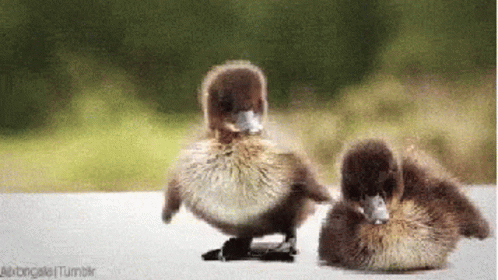
TW: Everything related to pregnancy and parenthood. Reader can get pregnant but no pronouns used.
☠️ SEBASTIAN SALLOW: ☠️

Sebastian disappears for days when you tell him you’re pregnant. He’s never thought about having children, never really thought anyone would want to have them with someone like him. He worries about being a bad father, that his impulsiveness and curiosity will get either you or his child hurt, and he can’t bare the thought of it. So he goes to the one person he knows will give it to him straight; Anne.
You’ll find him sitting next to her grave, his eyes raw from lack of sleep. He doesn’t even notice you sit next to him until you lean your head against his shoulder, and it’s then that he breaks down. He confides all of his fears to you, and you do your best to reassure him that he will be a wonderful father and that Anne would have been over the moon for him. You two eventually return to your home hand-in-hand, Sebastian’s chest a little lighter and his heart full of tentative excitement.
Sebastian is the stereotypical father. He’s the “fun” parent, the one who lets his child away with anything so long as he finds the humour in it, but he’s also extremely protective of both of you. He’ll do literally anything to keep you both safe and happy, and that can sometimes come off as controlling. Don’t worry, though, the minute you tell him off, he’ll take a step back and trust that you know what you’re doing.
Before your child even starts Hogwarts, they will be well-versed in all manner of defensive spells. If you happen to have a girl, Sebastian will be a strong advocate in naming her after her beloved aunt.
🐍 OMINIS GAUNT: 🐍
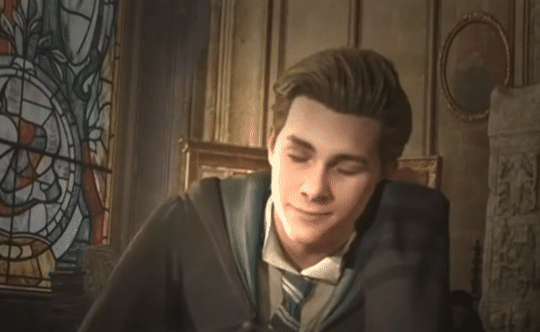
Ominis is conflicted when you tell him the news. You hadn’t been trying, but it’s not like you weren’t, either. He’s happy because he loves you, he loves the life you two have created far away from the influence of his family, but he’s also scared. He’s sure his family will learn of the new baby Gaunt and come looking for him. He’s heard rumours of their desperation, years of inbreeding causing most of them to become infertile, and their fear of “polluting” their name with muggle blood meant that the Gaunt line was finally dying out.
He approaches you one evening and declares that the child should have your surname. For that matter, he will also be taking yours, or you can both create an entirely new one and start your own little family without the shadow of cruelty and extremism hanging over your heads. He’ll tell his child about the Gaunts one day, but until then he wants nothing more than to protect them from an ideology that causes nothing but pain for everyone involved.
Ominis turns out to be the most doting father. He is so, so gentle with his child, but he’s not afraid to be stern with them when need be. He makes sure to instill acceptance into them from an early age, and you’ll find yourself close to tears when you find your child frequently standing up to bullies on behalf of others.
It feels like something shifts in Ominis after becoming a father. Suddenly, the empty crevice in his heart from everything he’s been through is full of joyous laughter and love. This is where he’s always meant to be, he thinks. With you and the family you have gifted to him.
🧪 GARRETH WEASLEY: 🧪

Garreth is over the moon, immediately rushing off to tell everyone and their dog in his excitement. You have to finally sit him down and tell him to stop sending owls when you receive a congratulations note from someone you’d only spoken to for five minutes outside the Three Broomsticks almost a decade ago.
You won’t need to lift a finger during your pregnancy, that’s for sure. Garreth will turn the world over if it means easing any of your discomfort, so prepare for breakfasts in bed, countless foot massages, and questionable potions (don’t worry, he tests them multiple times to make sure they won’t turn the baby into a dugbug). You start to feel guilty when every chore in the house is done before you even wake up, but he’ll insist that it’s the least he can do.
There is never a dull moment with Garreth and your child. Not only will you have dozens of little Weasley cousins flittering in and out of the house, but the two of them will team up to play innocent pranks on you all the time. Can’t find your broom? It’s been transfigured into a spoon and hidden amongst the cutlery, good luck! It’s not all fun and games, though. Garreth is a loving and doting father, and although you can sometimes feel like the “killjoy parent”, he’ll always have your back when it comes to parenting decisions and saying “no” to your child, even if it kills him to see their sad little expression.
Garreth will be happy with as many children as you’re willing to give him, but he would prefer a large family. All of that chaos can seem a bit overwhelming at times, but the Weasleys are more than happy to look after your child/ren whenever you need a break or want to spend some alone time together.
⭐ AMIT THAKKAR: ⭐

He is thrilled at the news, but also full of anxiety. He feels a deep responsibility to provide for both of you and that overwhelms him quite a bit in the beginning, but he’ll settle down after a few reassuring discussions with you and multiple assessments of your budget.
Amit will spend countless hours reading books on how to be a great father and how best to care for you during pregnancy. There isn’t a single book on the topic that he won’t read, and by the end of it, he considers himself a bit of an expert (”that’s all just theory, Amit!”). He is the type of person who will read to your stomach every night without fail. It could be the history of wizarding chess, or it could be The Tale of Beadle and the Bard, but these nightly stories quickly become the highlight of your evening as his soothing voice eases you into sleep.
He is the most supportive father on the planet. Although he would love it if your child shared his passion for magical history and stargazing, Amit will immerse himself in whatever they choose to do. Quidditch? He’s the dad cheering from the back during a practice session. Music? Your house is now full of various instruments, both muggle and magical. He’s convinced that his child will be the best at whatever they set their mind to, and he encourages them to never doubt their own mind or abilities.
Amit dedicates every single one of his books to you and your child/ren, both because he loves you, and because you’ve given him the motivation to work even harder at what he does. He wants all of your names to live on forever, and so he’s determined to publish books that will be read by many for years to come.
#hogwarts legacy#hogwarts legacy imagines#hogwarts legacy headcanon#harry potter#harry potter fanfiction#sebastian sallow#sebastian sallow x reader#ominis gaunt#ominis gaunt x reader#garreth weasley#garreth weasley x reader#amit thakkar#amit thakkar x reader#tw pregnancy
666 notes
·
View notes
Text
OKAY GUYS IM READY TO PRESENT MY THEORY WHO IS DANIEL FATHER!!!
disclaimer ; i haven’t seen such theory before, but if someone already wrote about it im sorry!!
disclaimer 2 ; i know it have a lot of plot holes, yet it was fun to think of!!
long story short ; since UI eyes seems to exist only in Yamazaki family i wanted to tie somehow this two facts, so Daniel’s mum isn’t his real mum, but they still blood related. Somi his real mum and Shintaro his father.
explanation ; SO! here goes my wild thought
so, since we know that Daniels mum said she had 3 siblings and now we know one of them was Jinyoung, but we have no idea who was the third one. i think Somi would be youngest or middle.
due to the fact that his mum said the only family she have is Daniel and other small part(and who said it necessarily his real father family? Daniel’s mum could really marry that man and he could be part of Jinyoung gang->)
i think she renounced her own family but why? because they were part of criminal world she didn’t want to participate in and probably have some connection to Yamazaki family! here i have two options 1) its either she doesn’t want to have arranged marriage and keep being part of criminal world, so she run away OR 2) Yamazaki rejected her as future wife because of certain reason, idk, infertility or something like that so she run away too (and this both facts explains why Somi was so desperate about serving her family)
but how it happened that Somi had another kid? after she moved from Shingen to Shintaro she may had a child with Shintaro but because he was depressed and lethargic as Shingen once was, (and since she showed very little of parental skills with helping Gun) she may decided to let Daniel rise in normal family with guess who? right! with Daniel’s mum! (and then i woke up and remembered about this huge age gap so it’s not gonna work😔🥀)
BUT i have another point here that after giving birth to Gun and after approximately 4-5 years Somi understood that Shingen probably will stay like that forever (which would be impressive plot twist honestly!!) so she lost any hope in him right there. and let’s be honest, Shintaro is a human too, so he probably had his disbelief moments too, maybe there was episodes where he lost his hopes in Shingen as well… so i bet Somi and Shintaro may had sex, idk in drunk state or something like that, so she ended up pregnant even tho they didn’t want to have any kids together (at least back then)
but how Somi endured and gave birth to small Daniel? remember when Gun explained Goo hostel story and how Yena’s mum went unnoticed during her pregnancy because she didn’t want that child or was afraid to tell somebody (i don’t remember correct reason tbh🙏🏻) and guess where Gun learned that information in first place? his mum went through this too!!….
how i feel after dropping that shit
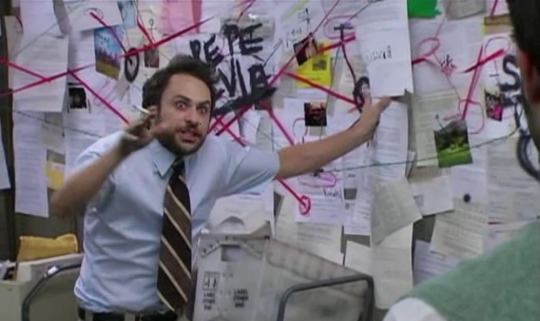
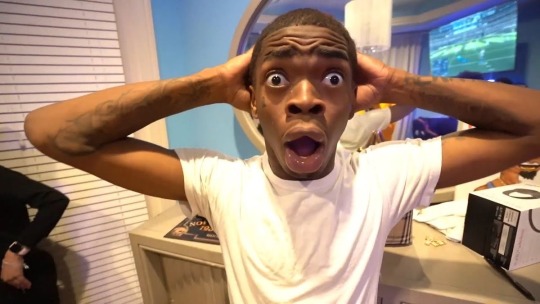
& how i stare at y’all trying not to look too freak🫡🫡
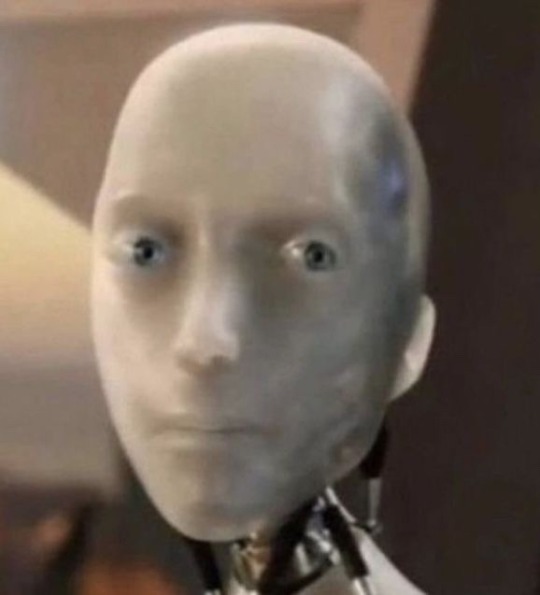


#[ ~ koi.talks🗣]#lookism#lookism thoughts#lookism theory#daniel park lookism#lookism daniel#daniel park#park hyungseok#gun park headcanons#gun park lookism#park somi#shingen yamazaki#shintaro yamazaki#yamazaki shingen#yamazaki gun#yamazaki
24 notes
·
View notes
Text
Town of Puddle: Vampires
Last updated 08/14/2023
In the world of Puddle, vampire is a catch-all term for any humanoid creature that needs to consume something from a human to survive - usually human flesh or blood, but some subsist on other things such as emotions, dreams, etc. The most common vampire is the classic undead vampire. Vampires are usually immortal or very long-lived.
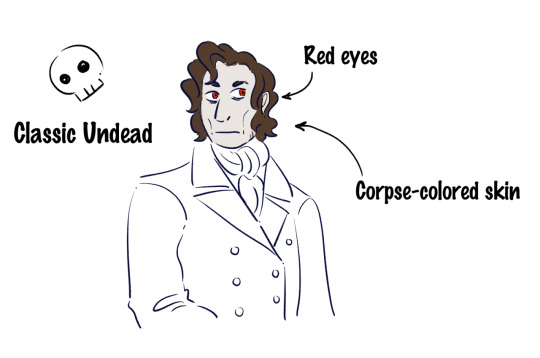
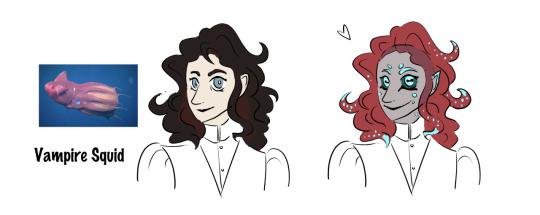
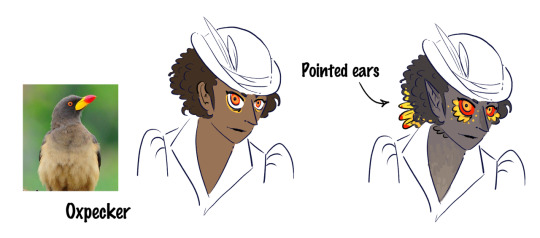

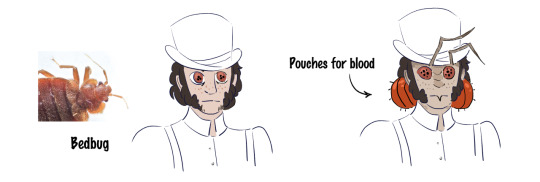

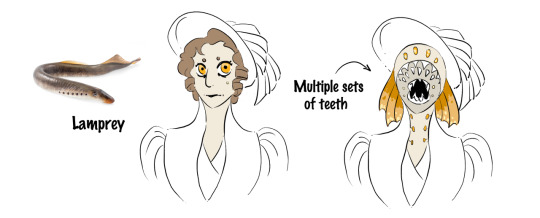

While vampires are thought to have any number of origins, there is in fact one singular origin from which they descend. The first vampires were nephilim, the children of the demon Asherah and the angel Rapha. Asherah was the queen of a kingdom named Hell. Tales of this kingdom and her rule would pass through the ages and become distorted into mythology. Rapha was an angel of blood with a terrible hunger his children would inherit. Both are long dead and gone, but their influence on their descendants lingers. Common vampiric powers, such as glamours and shapeshifting, come from these ancient ancestors.
Asherah and Rapha’s children were destined to rule, for a time anyway, over all corners of the earth. Some were more suited to the forests or mountains or cities, others to the sea or even the skies. These first vampires would eventually give rise to all the different types of vampires we see today.
The kingdoms of vampires were matriarchal, modeled after Asherah’s own kingdom. Matriarchs are a special type of vampire suited to rule, and childbirth. Mundane vampires have difficulty bearing children, most being completely infertile. Natural-born vampires are thus rare but not unheard of. Most vampires nowadays are turned, from human to vampire as other creatures are immune or will simply die to vampirism.
A childe (plural, childer) is a vampire that has been turned by another, who is their sire. One of the few remaining widespread cultural norms for vampires, is that a sire has some degree of responsibility for their childer shortly after they are turned, and it is good practice to teach them local vampire rules, history, and etiquette.
While most vampires prefer solitary existences, many vampires form groups for mutual support. These groups often vie for power in shadowy undergrounds that exist away from human eyes. A vampire group might be called a gang, a pack, or a coven.
Below are my named vampires so far. If you’re curious about even more, @wyrmzier also has their own Puddle vampire characters you can ask about.
Vivian Moon used to be human, but she was turned into a vampire. She is like a siphonophore, a colony inhabiting a human form. Because she is a colony of organisms she can survive grave injuries or even dismemberment, for short periods of time. When her limbs are separated from her body they have their own intelligence, like an octopus’s. Vivian works as a forensic consultant for a special precinct dedicated to investigating monster-related crimes.
Ethel Stone is Vivian’s friend in City Hall, who keeps her informed of political goings-on and secretly helps out her fellow vampires. Ethel is a lamprey vampire.
Teutho Melua is a vampiric pirate captain with a love of theatrics and parties. He is Vivian and Mordecai’s sire. Teutho is initially very narcissistic and bloodthirsty, but after some character development he becomes slightly less narcissistic. He is still bloodthirsty.
Mordecai Esadze is Teutho’s first mate. He is dark, serious, and grumpy, to balance Teutho’s more flashy personality. Mordecai is responsible and secretly more of a softie than he lets on.
Adelaide is Mordecai’s childe, his only one. As a human she sought the change, vampires call these sorts of humans “bite-chasers.” Now she manages a modest network of underground clubs and casinos, and in her spare time enjoys breeding snakes.
Lilian Heather is the adopted daughter of Samuel, and an up-and-coming actress.
Melanthios is an ancient vampire, thousands of years old and now more monstrous than humanoid. He is Menodora’s mate.
Malakos was the youngest of Menodora’s children, a cruel and egotistical vampire who controlled a small criminal empire on the Black Sea. He was Teutho’s sire, and was killed by Teutho and Mordecai.
Hyacinth is another of Malakos's childer, who pursues Teutho for a time.
Chise is Vivian’s mother, a bakeneko vampire. She abandoned Vivian at a young age, leaving her with no knowledge of her heritage.
Lycan was an ancient vampire, a child of Rapha and Asherah. His pursuit of a cure for vampirism led to the creation of werewolves.
Felisity is an ancient cat vampire, and a Matriarch. She was a queen of a small kingdom and was worshipped as an aspect of the goddess Bastet for many years, but eventually was dethroned and went into hiding.
256 notes
·
View notes
Text
A UCLA student is suing two California doctors, alleging they inappropriately "fast-tracked" her for an "irreversibly damaging" gender transition, starting when she was 12 years old.
Kaya Clementine Breen, now 20, filed her suit Thursday accusing Dr. Johanna Olson-Kennedy, who runs the nation's largest transgender youth clinic at Children’s Hospital Los Angeles, and numerous other defendants, of rushing her into transition to a male and overlooking her mental health struggles and history of sexual abuse.
"She needed psychotherapy," the suit reads in part. Instead, Breen was "fast-tracked onto the conveyor belt of irreversibly damaging" transgender medical procedures.
Breen began puberty blockers at age 12, started cross-sex hormones at 13 and underwent a double mastectomy at 14, according to the suit.
Olson-Kennedy diagnosed Breen with gender dysmorphia "mere minutes" into their first appointment and recommended puberty blockers at the same meeting, according to the suit, which accuses the doctor of concealing important information and even outright lying to Breen and her parents about the risks and necessity of treatments.
A spokesperson for Children’s Hospital Los Angeles told Fox News Digital on Monday that the Center for Transyouth Health and Development "has provided high quality, age-appropriate, medically necessary care for more than 30 years."
The spokesperson continued in an email that the center does not comment on pending litigation, nor does it comment on specific patients and their treatment.
Olson-Kennedy came under attack this fall after admitting to The New York Times that her team had not yet published research showing that puberty blockers did not lead to mental health improvements among young people to avoid the findings being "weaponized" by critics of transgender medical procedures.
Breen started seeing a therapist shortly before attending college and realized she "may not actually be ‘trans’ but rather had been suffering from PTSD and other issues related to her unresolved trauma," according to the suit.
She has since stopped taking testosterone and says her mental health has improved, but "her body has been irreversibly and profoundly damaged" to the point that she is "almost certainly infertile," the suit claims.
The Golden State has increasingly positioned itself as a sanctuary for transgender people, passing a shield law prohibiting police from cooperating with out-of-state prosecutions for people who seek transgender medical procedures and drugs in California, and banning school districts from notifying parents if their child identifies as a gender that's different from their school record.
Breen's lawsuit, which seeks unspecified damages, was filed the day after the Supreme Court heard oral arguments over whether states can ban gender transition care for minors.
Also named in her suit are Dr. Scott Mosser and the Gender Confirmation Center of San Francisco. Olson-Kennedy recommended Breen get top-surgery from Mosser, and surgery was scheduled "after a perfunctory virtual meeting" with someone on Mosser's staff, the lawsuit says.
The day of the surgery, Mosser met with Breen and her mother for less than 30 minutes before he "rubber-stamped" the operation.
A spokesperson for the Gender Confirmation Center cited HIPAA when declining to comment on "protected health information or pending litigation," but told Fox News Digital in an email that there is "no such thing as a rubber-stamped patient interaction at the GCC."
The center referred Fox News Digital to an additional statement from Mosser reading in part, "Our robust processes and protocols are designed to ensure that patients navigating our services fully understand the implications of the gender-affirming procedures they may choose to undergo as part of their transition."
The statement continued, "We regularly hear from former patients sharing updates about the overwhelmingly positive impact these surgeries have had on their lives—messages that continue to arrive many years after their procedures."
16 notes
·
View notes